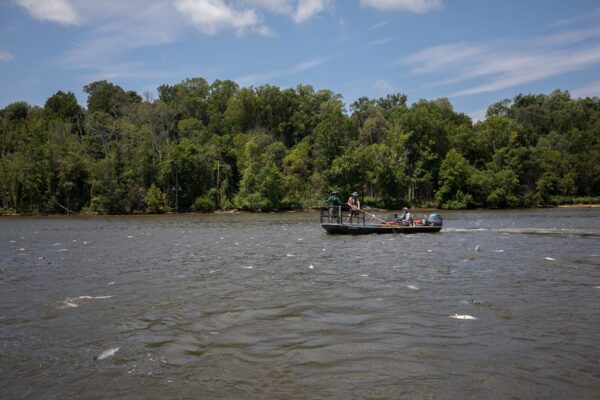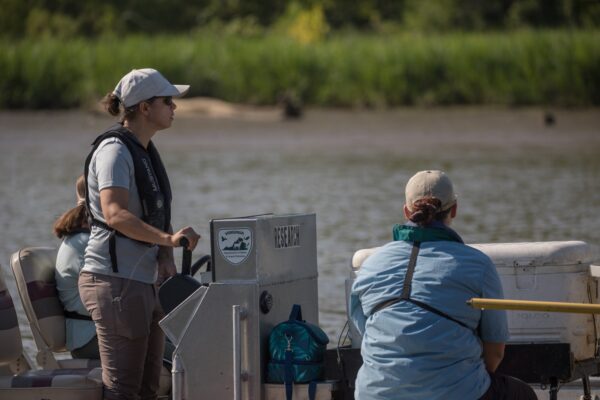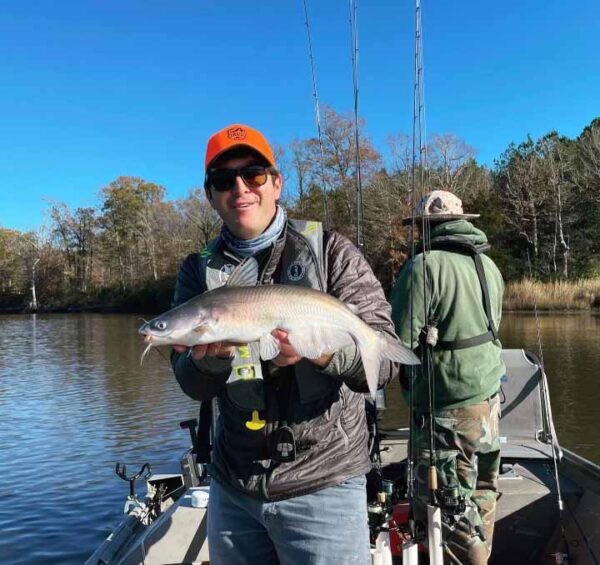A medium-size Blue Catfish being assessed - Photo by Meghan Marchetti/DWR
A large blue catfish about to be measured. Photo by Meghan Marchetti/DWR.
Fact File
Scientific Name: Ictalurus furcatus
Classification: Fish, Order Siluriformes, Family Ictaluridae
Size: Maximum 143 lbs. (current World and Virginia Record, Buggs Island Lake: 2011)
Life Span: Average 9-10 Years; Maximum 25 Years
Identifying Characteristics
- Whiskers on the sides and bottom of the mouth
- Spined pectoral and dorsal fins
- Bluish-gray body above, fading to white on sides and belly
- Deeply forked caudal fin (tail); and an anal fin with a straight margin
- Heavy-bodied with a wide head and dorsal hump (deepest point of the body, just in front of the dorsal fin)
- Upper jaw projects well beyond the lower
- Adipose fin
How to Discern from Similar Species:
Channel Catfish Ictalurus punctatus
- Channel Catfish have a rounded anal fin
- Smaller Channel Catfish (less than 20″) typically have many spots, Blue Catfish do not
White Catfish Ameiurus catus
- White Catfish in Virginia typically don’t exceed 15 inches
- White Catfish have a more emarginate (less forked) caudal fin, and a rounded anal fin
- White Catfish are a bullhead species, and possess a bulbous/rounded head
Diet
Blue Catfish are an omnivorous, or trophic generalist species of fish. Because of this, their diet varies by waterbody and the availability of prey items, but studies indicate that their diet most often consists of small fish, crayfish, mollusks, and plant matter. At larger sizes, Blue Catfish become increasingly piscivorous, and transition to primarily consuming other fish.
Distribution
Within Virginia, Blue Catfish are only native to the upper reaches of Tennessee River Basin. Established populations also exist within Virginia’s Chesapeake Bay tributaries (e.g., the James River) as well as tributaries to North Carolina’s Albermarle Sound (e.g., the Nottoway River). Blue Catfish can also be found in several of Virginia’s reservoirs and small impoundments.

Habitat and Reproduction
- The Blue Catfish is a freshwater species of fish that now thrives Virginia’s large, productive tidal river systems of the Chesapeake Bay
- Blue Catfish can often exhibit a nocturnal behavior – conserving their energy by lying in deep holes throughout peak daylight hours and relocating to shallower, moving water during low-light periods for optimal foraging
- Blue Catfish spawn once per year, in late spring and early summer. When the water temperatures reach 70 to 75 ºF, Blue Catfish will migrate out of their primary feeding zones to smaller bodies of water in order to seek out preferred spawning locations with underwater structure
- Female Blue Catfish can produce anywhere from 2,000 to 4,000 eggs per pound of body weight
- While both the male and female will tend to the nest, male Blue Catfish are the primary caretakers, and stay to defend their nest and brood
History of Blue Catfish in Virginia
Blue Catfish were initially introduced by The Virginia Department of Wildlife Resources (DWR) into the James and Rappahannock Rivers in 1974. Additional stockings took place within the York River watershed in 1985. The stocking of Blue Catfish in Virginia was completed with the goal of creating a recreational trophy fishery during a time when coastal Striped Bass populations were crashing throughout the entire Atlantic. While we achieved the goal of establishing a large predator trophy fishery in the absence of Striped Bass, these actions have had some unintended consequences that we continue to learn from.
Once established, the Blue Catfish population grew rapidly in Virginia through the 1990s. One unintended consequence of establishing this new fishery was the range expansion of Blue Catfish into adjacent river systems. When Blue Catfish were initially stocked in 1974, it was a common belief that the species would be confined to the rivers in which they were stocked. As of 2023, Blue Catfish have been documented in all of Virginia’s tributaries to the Chesapeake Bay, and are identified by DWR as an invasive species.

DWR Aquatics staff capture Blue Catfish during low-frequency electrofishing sampling. Photo by Meghan Marchetti / DWR
Assessing Effects of Blue Catfish in the Ecosystem
Blue Catfish now inhabit the same waters as several of Virginia’s iconic wildlife species. Many of these, such as Atlantic Sturgeon, American Shad, Blue Crab, and River Herring are invaluable from a cultural, commercial, ecological, and recreational standpoint . Because of this, DWR has prioritized its efforts to investigate and mitigate the negative effects of Blue Catfish on native and naturalized populations of aquatic wildlife.
Ongoing actions include:
- In-house biological surveys investigating Blue Catfish population trends, age and growth metrics, and timing and movement of various age classes
- Identification of overwintering sites, spawning locations, and summer aggregation areas
- Quantifying tributary-specific populations and the movement dynamics between other localized populations
- Supporting external researchers and collaborators in comprehensive diet studies of the Blue Catfish in Virginia’s tidal rivers (Schmitt et al. 2019; Evans et al. 2021; Fabrizio et al. 2021)
- Continued support and promotion of recreational angling, trophy fishing opportunities, increasing the visibility of Blue Catfish for culinary use
- Implementation of management goals and actionable items that reflect the agency’s mission

DWR Aquatics staff use species selective gears to better assess catfish populations. Photo by Meghan Marchetti / DWR
Management of Blue Catfish in Virginia
Although the Virginia Department of Wildlife Resources (DWR) manages the recreational fishery for Blue Catfish, while the Virginia Marine Resources Commission (VMRC) manages the commercial fishery for Blue Catfish, both agencies collaborate for the benefit of the Commonwealth of Virginia.
Current Recreational Regulation and Management Objectives:
James/Rappahannock/York Rivers below the fall line: no limit except 1 blue catfish per day greater than 32”
All other rivers below fall line: no limit.
This length limit is to promote increased angler participation through the available trophy fishery.
DWR encourages angler harvest of small blue catfish following consumption advisories set forth by the Virginia Department of Health.

Tidal Rivers Project Leader, Margaret Whitmore, leads aquatics staff on routine catfish monitoring and research activities. Photo by Meghan Marchetti / DWR
Recreational Opportunities and Tactics
As previously mentioned, Blue Catfish are currently ubiquitous in Virginia’s tidal tributaries to the Chesapeake Bay and are therefore readily accessible to anglers fishing the Commonwealth’s major river systems.

Aquatic Education Coordinator, Alex McCrickard, displays a great eating sized Blue Catfish after a successful day of fishing.
Beginner anglers can have success fishing in these areas with cut bait or scented catfish baits via Carolina rigs on the bottom (i.e., Fish Finder Rigs). The overabundance of small Blue Catfish in Virginia’s tidal rivers gives beginner anglers great opportunities at success when fishing with such setups. Further, anglers should look to utilize circle hooks, which will decrease the number of gut hooked fish and will make unhooking a fish much easier and safer. In most scenarios, weights ranging from ¾ oz – 1 ½ oz will suffice in holding baits within the targeted feeding zone. Anglers wishing to target slightly larger Blue Catfish can have success with medium to medium heavy spinning combos spooled with 15 to 20 lbs. monofilament.
Anglers searching for trophy Blue Catfish in deeper water will need to upscale the size of their equipment and use heavier tackle. Heavy conventional rods and reels are a must for targeting fish 30 pounds and larger. Many anglers use 60 lbs. or even heavier leaders with 8/0 circle hooks and 5 to 6 ounces of lead. Anglers should look to target deep holes and drop-offs with structure. Bends in the channel within tributary creeks can be popular places for Blue Catfish to stack up.

Fried Blue Catfish Tacos. Photo by Alex McCrickard / DWR
Sources
Evans H. K., A. J. Bunch, J. D. Schmitt, F. J. Hoogaker, K. B. Carlson. 2021. High-throughput sequencing outperforms traditional morphological methods in Blue Catfish diet analysis and reveals novel insights into diet ecology. Ecology and Evolution 11:5584-5597.
Fabrizio M.C., V. Nepal, T.D. Tuckey. 2021. Invasive Blue Catfish in the Chesapeake Bay Region: A Case Study of Competing Management Objectives. North American Journal of Fisheries Management 41:S156-166.
Schmitt J. D., B. K. Peoples, A. J. Bunch, L. Castello, D. J. Orth. 2019. Modeling the predation dynamics of invasive Blue Catfish (Ictalurus furcatus) in Chesapeake Bay. Fishery Bulletin.
Last updated: April 4, 2024
The Virginia Department of Wildlife Resources Species Profile Database serves as a repository of information for Virginia’s fish and wildlife species. The database is managed and curated by the Wildlife Information and Environmental Services (WIES) program. Species profile data, distribution information, and photography is generated by the Virginia Department of Wildlife Resources, State and Federal agencies, Collection Permittees, and other trusted partners. This product is not suitable for legal, engineering, or surveying use. The Virginia Department of Wildlife Resources does not accept responsibility for any missing data, inaccuracies, or other errors which may exist. In accordance with the terms of service for this product, you agree to this disclaimer.

